- Markforged Onyx Filament Review & Alternatives [2024] - December 11, 2024
- 17 Best Professional 3D Printers: Commercial, Desktop, & Industrial [2024] - December 10, 2024
- Best 3D Printers (Industrial, Desktop, & More) [2024 Guide] - July 20, 2024
Additive manufacturing (AM) is the process of making three-dimensional objects from a CAD model. It’s also commonly referred to as 3D printing. This technology is gaining popularity due to its varied production capabilities, cost-effectiveness, and efficiency.
How exactly is additive manufacturing changing the way products are designed and produced? And what are the advantages of using this 3D printing technology?
This article will cover how additive manufacturing works, different AM technologies, and the benefits it provides to businesses and consumers.
What is Additive Manufacturing? How Does it Work?
Additive manufacturing refers to various processes used to create three-dimensional objects layer by layer using computer-aided designs (CAD). As the name implies, additive manufacturing “adds” material together to create an object. This is different from traditional subtractive manufacturing, like CNC machining, which removes excess material from a block of material.
The AM process begins with a planning and design phase, where CAD software is used to create a 3D model. After the design is finalized, the CAD is placed in to build setup software, the build parameters are set, and then this is sent to the printer.
Next, materials are loaded into the 3D printer. While plastics remain popular, metals, ceramics, and composites are all being used.
Once the setup software and materials are added to the 3D printer, it will begin constructing your object layer-by-layer according to software directions. Depending on the technology employed, some printers employ ultraviolet light that hardens liquid resin into plastic. In contrast, others use intense heat to melt plastic filaments or employ lasers to fuse small particles of polymer powder together.
After the printer completes to build, the post-processing stage then ensures that your product is ready for use. Depending on what was built, these processes can range from rinsing with solvents and removing support structures to sanding and painting. This cannot only improve the surface quality of your object but also its mechanical properties. Then, your product is ready for use.
Additive Manufacturing vs. Conventional Manufacturing
The additive manufacturing process is different from the conventional subtractive and formative manufacturing processes, such as machining and injection molding. Machining involves cutting away parts of the material, and injection molding heats thermoplastics and injects them into a machined mold to give it the desired shape.
Compared to traditional manufacturing processes, AM can be cost-effective, create less waste, and have shorter production times. It also offers greater flexibility and creativity in design since the layer-by-layer process allows for intricate details and complex geometries that are difficult to achieve with conventional manufacturing.
Additive Manufacturing Processing Types & Technologies
Additive manufacturing covers a wide range of manufacturing techniques, technologies, and materials. They include:
1. Material Extrusion, FDM, or FFF

Material extrusion works by pushing a plastic filament through a heated nozzle to form an object layer-by-layer, using the created model instructions. The deposition process is usually done under a vacuum to prevent the filament from cooling too quickly and forming gaps in the object.
Also referred to as fused deposition modeling (FDM) or fused filament fabrication (FFF), material extrusion technology is best for creating large parts with simple geometries from various materials.
Benefits:
- Material extrusion is a relatively simple process that can be used with various materials, including metals, plastics, and composites.
- Lower-temperature process
2. Vat Photopolymerization
Vat photopolymerization is an additive manufacturing technique that involves selectively curing a photosensitive resin with UV light. It works by solidifying very thin layers of liquid photopolymer, which are cured when exposed to UV light.
In vat photopolymerization, the object is created by curing the resin with a projector or laser. When curing, the build platform is lowered incrementally to allow for further layers of resin. This process is repeated until the desired object is created.
Several generations of resin 3D printers have been developed, such as Stereolithography (SLA), Digital Light Processing (DLP), Masked Stereolithography (mSLA), and CLIP/DLS.
Benefits:
- Vat photopolymerization allows for highly accurate objects with smooth surfaces.
- It is also a relatively fast process compared to other 3D printing technologies.
- The process is cost-effective.
- It also allows various materials.
Stereolithography (SLA)

Stereolithography (SLA) is a type of 3D printing technology that uses photosensitive resin to form objects layer-by-layer. Since entering the market in the 1980s, Stereolithography (SLA) has become one of the most popular 3D printing technologies and is great for printing various projects, including very large parts.
It works by selectively curing the resin with an ultraviolet laser, which solidifies and forms the object. It’s used for producing highly intricate objects with smooth surfaces and accurate details.
Digital Light Processing
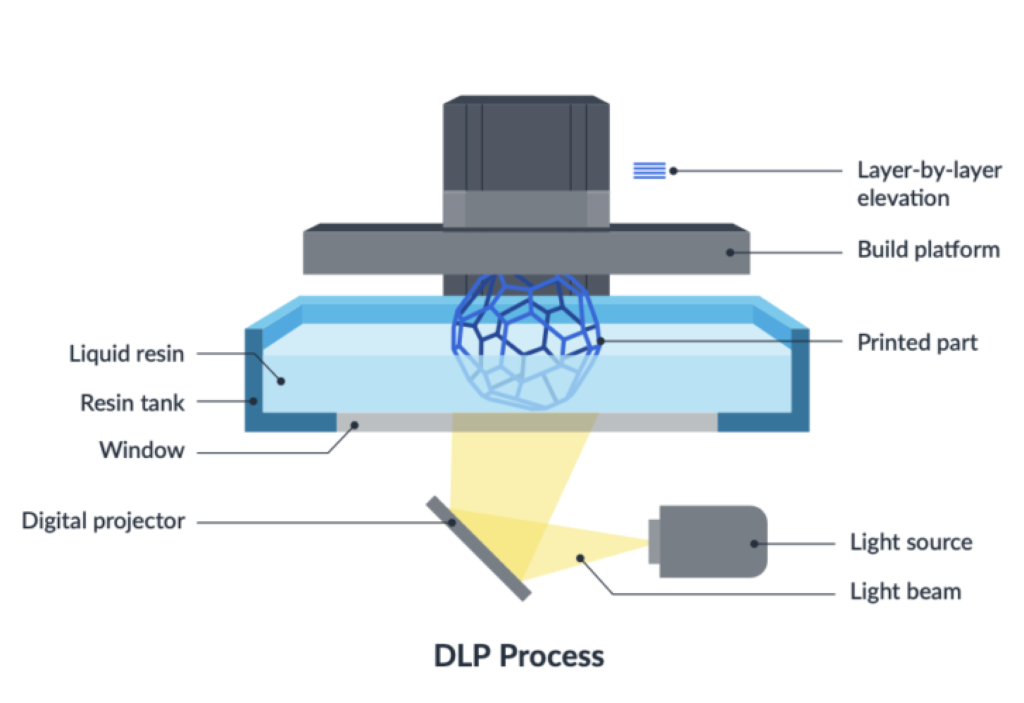
Digital Light Processing (DLP) is another type of 3D printing technology that uses projected light to cure photopolymer resins and form an object layer-by-layer. A projector or digital light source is used to project a single image of the desired object onto the liquid resin. When the resin is exposed to light, it begins to harden and form the object.
For many 3D users, DLP is an upgrade from the original SLA process since it allows for faster printing times and higher-resolution objects. However, the speed and quality issues from earlier SLA machines persist. Although the print speed may not be affected, the object’s surface finish and accuracy may suffer.
DLP also only has one projection source, which makes it challenging to produce images with complex geometries and accurate build quality. Plus, DLP chips and components can be expensive. These disadvantages can limit innovation.
Masked Stereolithography (mSLA)

Masked stereolithography (mSLA) is one of the latest forms of traditional SLA 3D printing. This additive manufacturing technology uses an LED array light source instead of a laser or a single projection point. The 3D printer matches an LCD panel with the LED array and masks the pixels when printing, allowing only necessary pixels through the light.
Nexa3D’s resin 3D printers use a proprietary version of mSLA technology called Lubricant Sublayer Photo-curing (LSPc). While mSLA itself is one of the fastest technologies–using an LCD light engine to project UV light across the build platform to cure a full layer of the print at once–LSPc makes it even faster. This technology combines a UV light array and LSPc Optical lens layer to ensure light uniformity in this process, which is essential for optimal use of LSPc High Contrast Mask.
The LSPc HC Mask projects 3D image slices onto the vat where the photopolymerization process takes place layer by layer. This provides the fastest printer on the market with the largest build area in its class without sacrificing image quality: you get high edge-to-edge performance with no distortion, unlike with DLP 3D printers.
CLIP/DLS
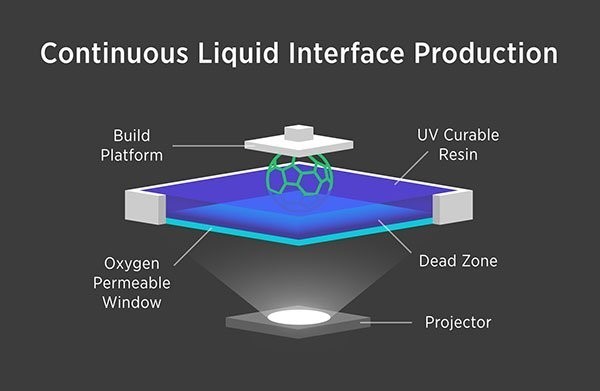
CLIP/DLS is a photochemical technique that uses a digital light projector to cure photosensitive materials. An oxygen-permeable window is used to help control the oxygen environment, which helps facilitate rapid curing times and allows for a uniform part build. It allows for a continuous process, rather than moving layer by layer. resulting in parts that are built quickly and with a high degree of accuracy and detail.
The benefits of this technique include being able to produce parts with complex geometries, such as internal channels, cavities, and threads in one pass. Additionally, it can create fine features that are not possible with other additive manufacturing processes.
However, while this technique builds almost as fast as LSPc, many materials in this process require both a UV and thermal post-cure of several hours before they are complete. This adds substantially to both the post-processing and overall manufacturing time.
3. Material Jetting
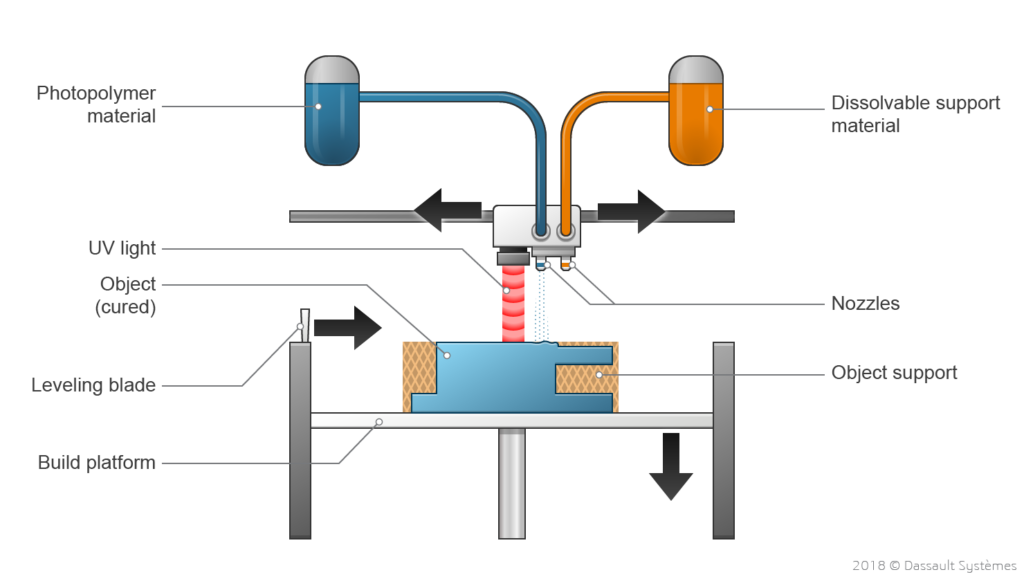
Material jetting additive manufacturing creates objects similar to 2D printers. This type of 3D printing uses a liquid material–usually in the form of photopolymers or waxes–and an inkjet-like printing head to create 3D objects
The printhead is placed above the build platform and then dispenses droplets of photosensitive polymer material on the surface using a thermal method. The droplets solidify under ultraviolet (UV) light and further layers are built until the process is complete. The layers are then cooled before post-processing begins.
Material jetting is compatible with various materials including ABS-like, rubber-like, and fully transparent materials. It’s also ideal for multi-material printing, combining up to 7 resins in one print. Products have higher dimensional accuracy and a smoother surface finish.
Benefits:
- Material jetting offers high print speed and accuracy in multi-color and multi-material parts.
- Material jetting is regarded as the best for multi-color printing, medical modeling, and haptic prototypes.
4. Powder Bed Fusion with Polymers
Powder bed fusion with polymers is a 3D printing process that uses an infusing system to build parts directly from liquid materials. The process involves using a pre-heated bed and high pressure to force the material into a mold or form, which is then cured.
Powder bed fusion can be used with thermoplastics and materials to produce complex geometries.
Benefits:
- Complex geometries with little to no support structures.
- Produces multiple parts simultaneously and saves time and money.
- Builders get high levels of accuracy and repeatability.
Selective Laser Sintering

Selective Laser Sintering (SLS) is the most common type of powder bed fusion. This additive manufacturing technology uses a laser to fuse small particles of various materials like plastic powders into a solid object. SLS works by heating a bed of powder material with a laser to selectively melt parts of the powder.
Once melted, the powder solidifies and forms a layer of the desired part shape. A new layer of powder is added above this melted layer, subsequently melted and fused to the layer below. This process is repeated until the entire part has been constructed. One of the benefits of SLS is that the part is supported by the unmelted powder surrounding it, thus allowing for the manufacture of complex components with no support structures.
Unlike other SLS printers, Nexa3D’s QLS 820 is powered by Quantum Laser Sintering technology. It delivers premium production capabilities with incredible speed, end-to-end traceability, centralized printer management, real-time data monitoring, and the highest throughput in its class.
QLS employs one of the fastest printing speeds of any powder bed fusion technology, up to 8 liters per hour, providing accurate, repeatable manufacturing of production components.
Multi-Jet Fusion

Multi-Jet Fusion (MJF) is another type of powder bed fusion technology. MFJ uses a high-intensity light source to selectively fuse particles of a material, usually nylon or polymers, to create an object in one step.
The process begins with a material layer that’s heated from below with a heater plate. The layers are then combined by jets of fusing and detailing agents. It helps create parts quickly with great accuracy and surface finish quality.
5. Powder Bed Fusion with Metals
Powder bed fusion with metals involves melting metals (e.g., titanium, stainless steel, aluminum) layer by layer with a high-power laser controlled by a CAD program until the desired part geometry is obtained.
Powder bed fusion includes other methods like direct metal laser sintering (DMLS), selective laser melting (SLM), and electron beam melting (EBM).
Benefits:
- A high degree of accuracy and detail in the manufactured parts
- Ability to produce complex geometries
- Parts with superior mechanical properties due to the homogeneous microstructure of the material used
Direct Metal Laser Sintering

Direct Metal Laser Sintering (DMLS) is a type of powder bed fusion technology used to produce metal parts. It uses a high-intensity laser to fuse small, powdered metal layers into a solid object. DMLM parts have a surface finish comparable to a fine investment casting part, and many times expert finishing services are required
Selective Laser Melting

Selective Laser Melting (SLM) is similar to DMLS except that it completely melts the metals (it doesn’t just sinter them). In SLM, the laser fuses the powder’s small areas to form a solid part. The unfused powder serves as support structures and helps reduce warping and distortion.
Electron Beam Melting

Electron Beam Melting (EBM) requires a vacuum chamber and uses an electron beam to fuse small powder particles into solid metal parts.
6. Binder Jetting

Binder jetting deposits a liquid binder onto a powder bed to join the particles and create the desired shape. A layer of powder is spread evenly over the build platform and then the print head moves over the powder bed to selectively deposit the binder onto the powder. The binder binds the particles together and creates the desired shape.
After the binder is deposited, the build platform is lowered, and another layer of powder is spread. The process is then repeated until the object is complete. Depending on the material, the part may then go into a debind/sintering oven as is the case with metal before the part reaches its final performance specs. The most common type of binder jetting is selective deposition modeling (SDM).
Benefits:
- Binder jetting accommodates various materials, including metals, ceramics, and plastics.
- It offers high levels of accuracy and repeatability
7. Direct Energy Deposition (DED)
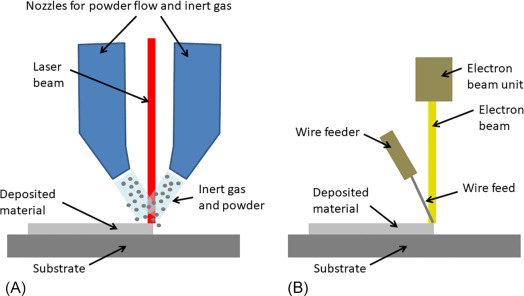
Direct Energy Deposition (DED) is a type of additive manufacturing process that uses a high-powered beam to melt metal powder or wire onto the surface of an existing part. It’s an ideal method for creating complex parts and repairing existing components with minimal waste.
In this additive manufacturing process, the material is melted on the surface of the part. This means parts with complex geometries are to be produced quickly and accurately.
Benefits:
- Direct Energy Deposition (DED) has a higher deposition rate which makes the production rate faster. Thus, it is ideal for large metal objects such as rocket nozzles.
- The DED technology is also often used to repair or enhance existing objects.
8. Sheet Lamination

Sheet lamination technology builds parts layer by layer through the adhesion of metal sheets. The process begins with a stack of flat sheets placed on the build platform which is cut into shapes and then layered together. The build platform is then lowered, and another layer of sheets is placed on top.
Sheet lamination 3D printing often uses Laminated Object Manufacturing (LOM) or Ultrasonic Additive Manufacturing (UAM). LOM involves alternate layers of material and adhesive to produce items with visual and aesthetic appeal, while UAM employs ultrasonic vibrations to weld layers of material together.
Benefits:
- Sheet lamination is ideal for producing large objects.
- Sheet lamination also has quick cutting speeds and fast cycles, making it a fast 3D printing technology for builders.
What are the benefits of additive manufacturing?
Additive manufacturing offers numerous benefits, especially its ability to produce complex parts without the need for expensive tooling quickly. Here are some of the benefits 3D printing offers:
Reduced waste
Additive manufacturing produces only what is needed, reducing waste and minimizing costs. Businesses can save money on inventory costs by only producing parts and products when they are needed.
Improved productivity
3D printers are known for offering significantly faster speeds than traditional manufacturing which reduces lead times and increases production output.
Plus, some additive manufacturing technologies like mSLA have drastically reduced production time. mSLA uses LED/LCD light engines to project UV light across the build platform to cure a full layer of the print at once. Nexa3D’s LSPc technology goes a step further utilizing a patented lubricated Everlast 2 membrane.
This membrane significantly reduces the “peel force” imposed as each layer is lifted off of the base of the vat. It provides the fastest printer on the market with the largest build area in its class, all without sacrificing image quality.
Scalable & sustainable manufacturing
Additive manufacturing makes it possible to scale production when demand increases, reducing the need for upfront investment. This method also offers quick iterations and customization at low cost, making it ideal for prototyping and small-batch manufacturing.
On-demand printing of exactly the quantity you need means manufacturers no longer have vast inventories of unused parts that could go obsolete. This can lower transportation and logistics costs–thereby reducing an organization’s overall carbon footprint.
Composition variability
Additive manufacturing enables you to use various materials, including metals and plastics. This flexibility makes it easier to design complex parts with multiple mechanical properties.
Construction complexity
3D printing provides complex geometries that are difficult or impossible to achieve with traditional manufacturing. This enables designers and engineers to create intricate designs that make products lighter, stronger, and more efficient.
For example, resin 3D printers can print very fine features as low as 10 microns, reducing the need for post-processing and increasing achievable part complexity and detail.
What are the challenges in additive manufacturing?
Additive manufacturing is not without its challenges. Some potential limitations include:
Implementation Costs
One challenge in additive manufacturing is the upfront cost of investing in a 3D printer and associated materials.
Some quantifiable cost drivers include:
- The printer: The biggest upfront expense is the price of the 3D printer.
- Materials: How much material are you using? What’s the cost associated with producing a given part/component?
- Electricity: How many kWh/hour will my printer consume?
- Labor and time: Is this methodology faster than traditional manufacturing of the product?
Depending on the given application and the existing production methodology, the savings you can make by using a printer can be significant.
Using advanced 3D printing technology like Nexa3D’s will offer a high return on investment. For instance, the NXE 400Pro 3D printer provides exceptional affordability for designers, engineers, and manufacturers who need fast, accurate, and cost-effective prototyping and manufacturing solutions.
Determining Project Viability
Many builders also face the challenge of determining the project viability. This can be difficult, especially with the time-consuming and decision-making processes 3D users face. However, with today’s advanced technologies, it’s become easier to evaluate what type of 3D printing solution will work best for your project.
Quality and Speed Tradeoff
Some 3D printers compromise speed for quality because heat buildup from the rapid printing can cause warping and other defects. However, advanced 3D printers can maximize speed and quality – without compromising either.
Nexa3D’s LSPc technology addresses common concerns over usable power, image homogeneity, layer separation, resin replenishment cycles, and heat buildup during the build process, making it the most successful at solving historical speed vs. quality problems.
Examples & Use Cases of Additive Manufacturing
Medical Devices
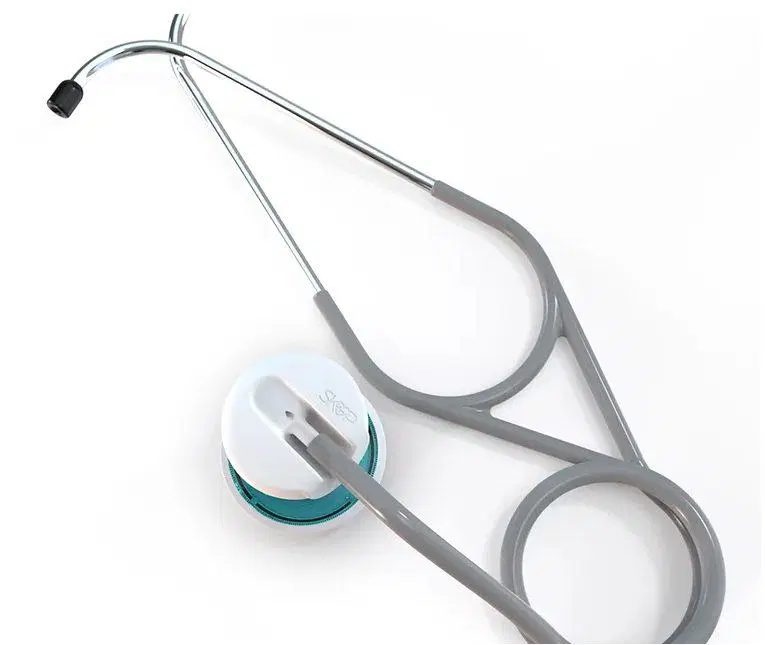
Additive manufacturing is being used to create medical devices, prosthetics, implants, and tissue engineering scaffolds. 3D printing technology enables the creation of complex parts with high accuracy that are tailor-made for specific patient needs
WeMed took bold steps to adopt 3D designs for its telemedicine devices. After discovering the importance of remote diagnostic medical devices, WeMed partnered with Nexa3D to produce the SKOP™ 3D printed stethoscope. Through this initiative, WeMed started creating more affordable and accessible cardiopulmonary auscultation medical devices.
3D printers are also ideal for dental prosthetics, splits, dentures, and much more. Nexa3D’s NXD 200Pro 3D printer is perfect for dental labs that need fast and accurate production of crowns, bridges, inlays, and Onlays models. This device offers ultrafast and sophisticated dental model manufacturing capabilities with a print time of fewer than 30 minutes.
Industrial Manufacturing
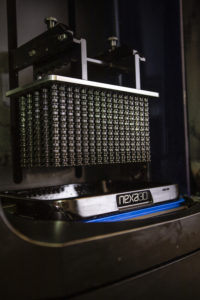
Additive manufacturing has also become an important part of industrial manufacturing. Companies can produce high-quality and complex parts in a fraction of the time required with traditional manufacturing methods. This helps reduce lead times, costs, and wastage while increasing product quality.
For instance, builders use an advanced industrial 3D printer like the NXE 400Pro photopolymer 3D printer. This printer boasts an unprecedented 17L build volume, delivering unmatched speed and throughput without compromising accuracy or repeatability.
Auto & Aerospace Industries
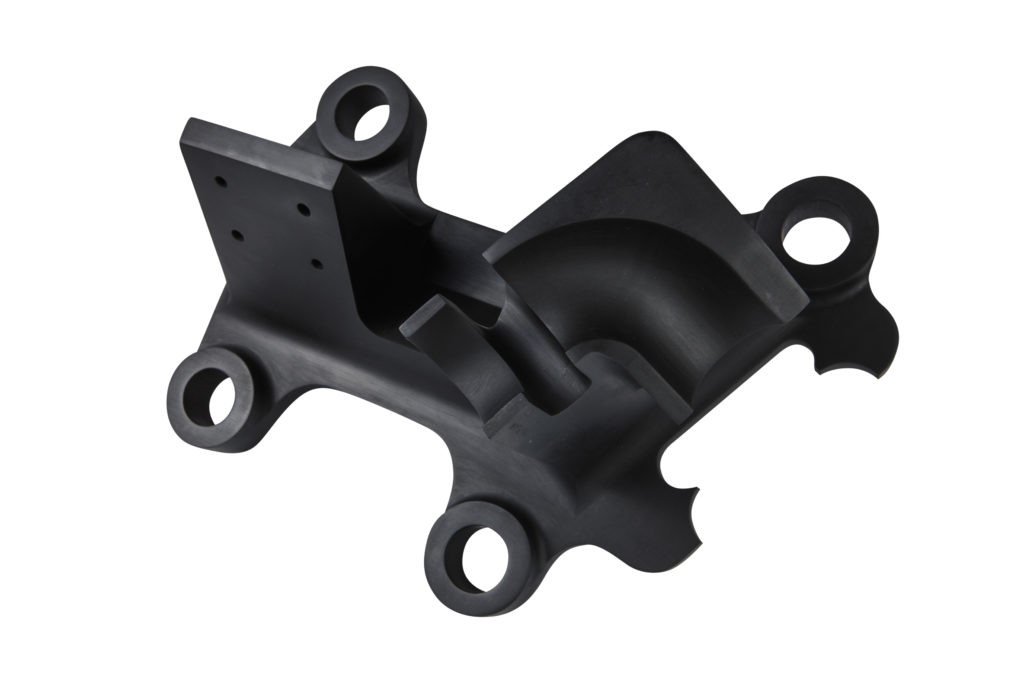
The auto and aerospace industries are constantly adopting new technologies to reduce their time-to-market and increase production efficiency. Additive manufacturing plays a key role in the automotive industry, with 3D printing being used for prototyping, customizing parts on demand, and creating complex geometries.
Williams Racing F1 partnered with Nexa3D to use its NXE400 3D printer testing operations. Through NXE400’s ultrafast printing, Williams F1 iterates and facilitates faster print/check/modify/print/repeat cycle. Therefore, they achieve higher refinement standards at an ultrafast rate.
In the aerospace industry, 3D printing is used to design customized components, such as turbine blades, and for prototyping a wide variety of parts. Companies also use 3D printing to reduce the number of individual components in an assembly, making them lighter and more cost-effective. For instance, 3D printers are perfect for minor repairs like fixing non-essential parts like air ducts, window trays, etc.
Moldmaking & Mold Development
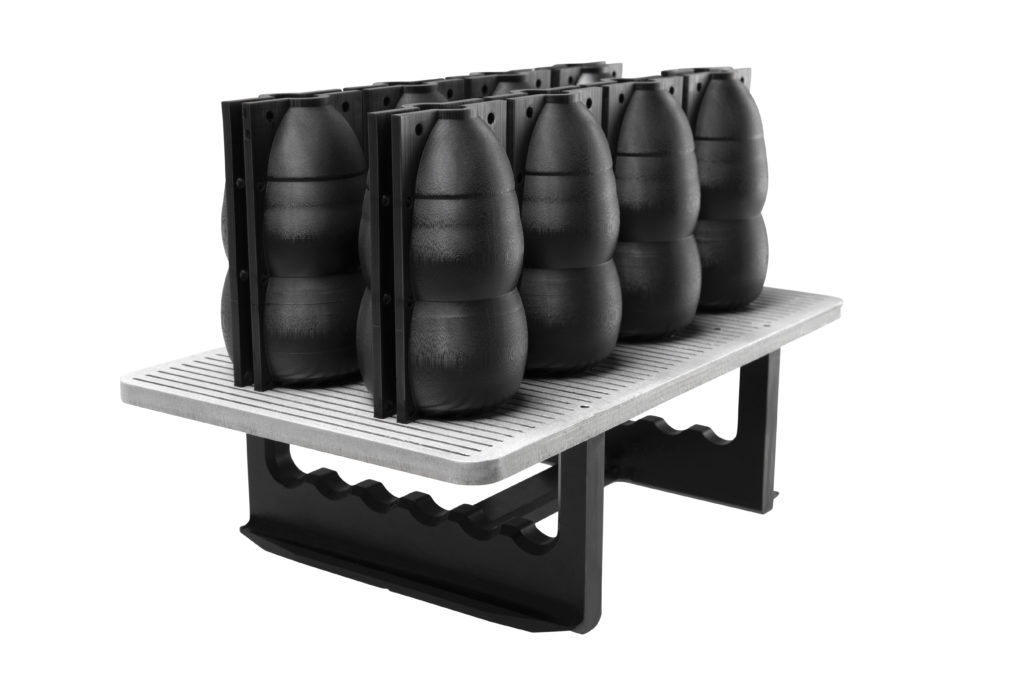
With industrial 3D printers, it is possible to quickly create molds for the mass production of plastic parts. This reduces the cost of injection molding by minimizing lead times and ensuring precision at every step.
For instance, PepsiCo streamlined their blow mold development process from 4 weeks down to just 5 days with the help of 3D printing.
Hobbyists
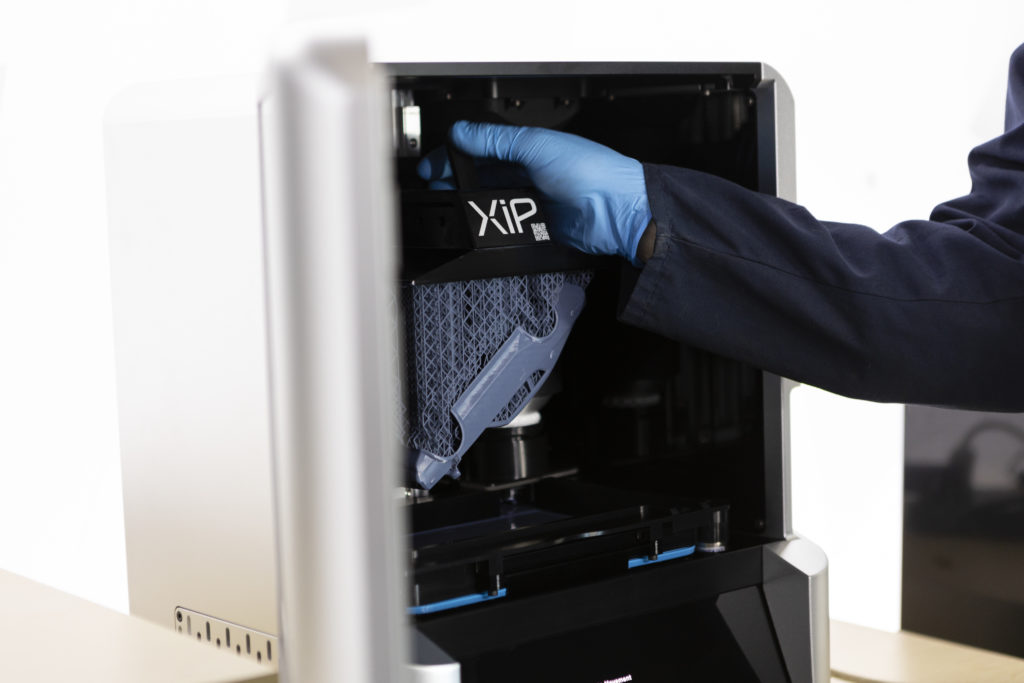
Hobbyists also use 3D printing to create various projects, from custom figurines to jewelry and furniture. 3D printers allow hobbyists to quickly bring their ideas to life without any design or manufacturing knowledge.
Additive Manufacturing FAQs
Who invented AM?
Charles “Chuck” Hall, an American scientist and inventor, is credited with inventing the first 3D printer in 1986. The engineer expanded the additive manufacturing process through advanced Stereolithography (SLA) technology, which was later patented through his company, 3D Systems.
Is additive manufacturing the same as 3D printing?
Yes, additive manufacturing and 3D printing are the same. Additive Manufacturing is the umbrella term used to define all processes that involve building parts by gradually adding material in layers, while 3D printing is a subset of AM.
What materials are used in additive manufacturing?
The most common materials used in 3D printing are photopolymer resins and thermoplastic polymers such as ABS, Polycarbonate, Nylon, and PLA. Other materials used in AM include metals (like stainless steel and titanium) and composites (like carbon fiber-reinforced plastics).
How long does the process take?
Although 3D printing is faster than traditional manufacturing processes, the 3D printing time depends on factors like size, complexity, etc. Regardless, a sophisticated 3D printer can produce results within minutes without compromising quality.
Use the Best Additive Manufacturing Technology
Additive manufacturing technology is constantly solving complex manufacturing problems and redefining what is possible. But to make the most of your 3D printing projects, you need to work with the best 3D printing technology.
Nexa3D’s 3D printers achieve the fastest printing speeds and highest throughput in their class. From the XiP to the NXE Pro series, Nexa3D printers are known for their groundbreaking combination of speed and quality.
Experience it yourself with a free sample part from our resin 3D printers.
Or, learn about the latest 3D printing materials for ultrafast 3D printing.

